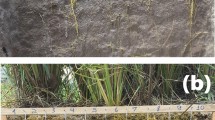Abstract
Roots in the Wageningen Rhizolab are observed using two methods: (i) non-destructively, using horizontal, glass minirhizotrons at intervals of 14 days between observations; (ii) with destructive sampling using augers on three dates in the season. This paper reports changes with depth and time in root numbers per unit interface area of the minirhizotron tube (number of intersections) of four crop species (wheat, Brussels sprouts, leek and potato). The number of root intersections of Brussels sprouts, wheat and potato declined with depth at any time, whereas leek showed a different pattern because maximum root growth was observed at a depth of 10–20 cm. Root density generally decreased in the following order: Brussels sprouts, wheat, potato and leek. Plots of root length densities, Lrv(cm. cm-3), obtained by auger sampling, versus the number of intersections showed considerable variation in slope with species, time in the season and year, implying that a single, universal equation to convert minirhizotron observations into volumetric root densities does not exist. Causes of variation in the slopes are discussed. It is concluded that limited auger sampling combined with minirhizotron observations yield adequate quantitative estimates of relevant root properties.
Similar content being viewed by others
References
Barraclough, P B 1986 The growth and activity of winter wheat roots in the field: nutrient inflows of high-yielding crops. J. Agric. Sci. 106, 53–59.
Bragg, P L, Govi, G and Cannell, R Q 1983 A comparison of methods, including angled and vertical minirhizotrons, for studying root growth and distribution in a spring oat crop. Plant and Soil 73, 435–440.
Cheng, W, Coleman, D C and Box, J E Jr 1991 Measuring root turnover using the minirhizotron technique. Agric. Ecosyst. Environ. 34, 261–267.
De Willigen, P and Van Noordwijk, M 1987 Roots, plant production and nutrient use efficiency. PhD. thesis. Agricultural University Wageningen, the Netherlands. 282 p.
Ferguson, J C and Smucker, A J M 1989 Modifications of the minirhizotron video camera system for measuring spatial and temporal root dynamics. Soil Sci. Soc. Am. J. 53, 1601–1605.
Goedewaagen M A J 1942 Het wortelstelsel der landbouwgewassen. Rijkslandbouwproefstation en bodemkundig instituut te Groningen. Algemeene Landsdrukkerij, 's Gravenhage, 171.
Huck, M G and Taylor, H M 1982 The rhizotron as a tool for root research. Adv. Agron. 35, 1–35.
Lang, A R G and Melhuish, F M 1970 Lengths and diameters of plant roots in non-random populations by analysis of plane surfaces. Biometrics 26, 421–431.
Majdi, H, Smucker, A J M and Persson, H 1992 A comparison between minirhizotron and monolith sampling methods for measuring root growth of maize (Zea mays L.). Plant and Soil 147, 127–134.
Melhuish, F M and Lang, A R G 1968 Quantitative studies of roots in soil. 1. Length and diameters of cotton roots in a clay-loam soil by analysis of surface-ground blocks of resin- impregnated soil. Soil Sci. 106, 16–22
Parker, C J, Carr, M K V, Jarvis, N J, Puplampu, B O and Lee, V H 1991 An evaluation of the minirhizotron technique for estimating root distribution in potatoes. J. agric. Sci, Camb. 116, 341–350
Payne, R W, Lane, P W, Ainsley, A E, Bicknell, K E, Digby, P G N, Harding, S A, Leech, P K, Simpson, H R, Todd, A D, Verrier, P J and White, R P 1987 Genstat 5 Committee Rothamsted Exp. Station. Reference Manual. Clarendon Press, Oxford, 749 p.
Smucker, A J M, McBurney, S L and Srivastava, A K 1982 Quantitative separation of roots from compacted soil profiles by the hydropneumatic elutriation system. Agron. J. 74, 500–503.
Tennant, D 1975 A test of a modified line intersect method estimating root length. J. Ecol. 63, 995–1001.
Upchurch D R 1986 Conversion of Minirhizotron-Root Intersections to Root Length Density. In Minirhizotron Observation Tubes: Methods and Applications for Measuring Rhizosphere Dynamics. ASA Special Publication Number 50, 51–65.
Van de Geijn, S C, Vos, J, Groenwold, J, Goudriaan, J and Leffelaar, P A 1994 The Wageningen Rhizolab — a facility to study soil-root-shoot-atmosphere interactions in crops. I. Description of the main functions. Plant and Soil 161, 275–287.
Van de Willigen, Voorhees, W B 1976 Root elongation along a soil-plastic container interface. Agron. J. 68, 143
Vos, J and Groenwold, J 1983 Estimation of root densities by observations tubes and endoscope. Plant and Soil 74, 295–300.
Vos J and Groenwold J 1987 The relation between root growth along observation tubes and in bulk soil. In Minirhizotron Observation Tubes: Methods and Applications for Measuring Rhizosphere Dynamics. ASA Special Publication Number 50, 39–49.
Author information
Authors and Affiliations
Rights and permissions
About this article
Cite this article
Smit, A.L., Groenwold, J. & Vos, J. The Wageningen Rhizolab — a facility to study soil-root-shoot-atmosphere interactions in crops. Plant Soil 161, 289–298 (1994). https://doi.org/10.1007/BF00046400
Received:
Accepted:
Issue Date:
DOI: https://doi.org/10.1007/BF00046400




